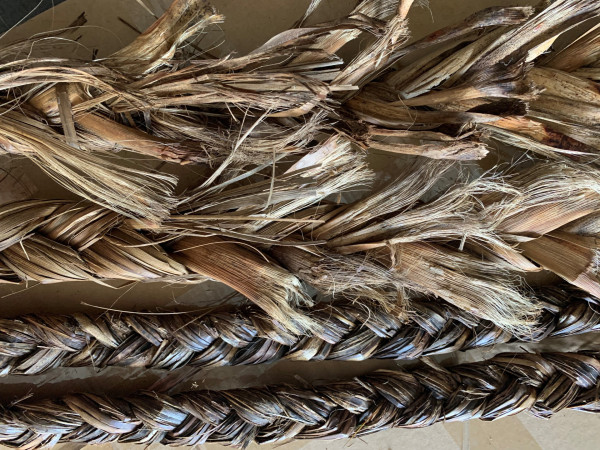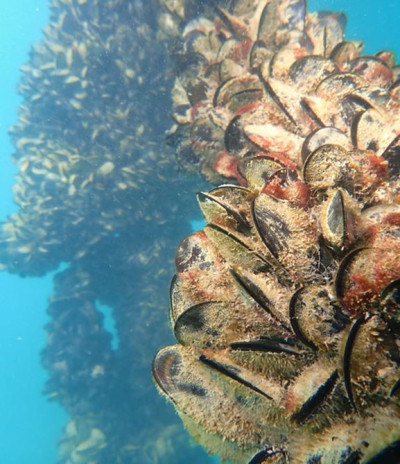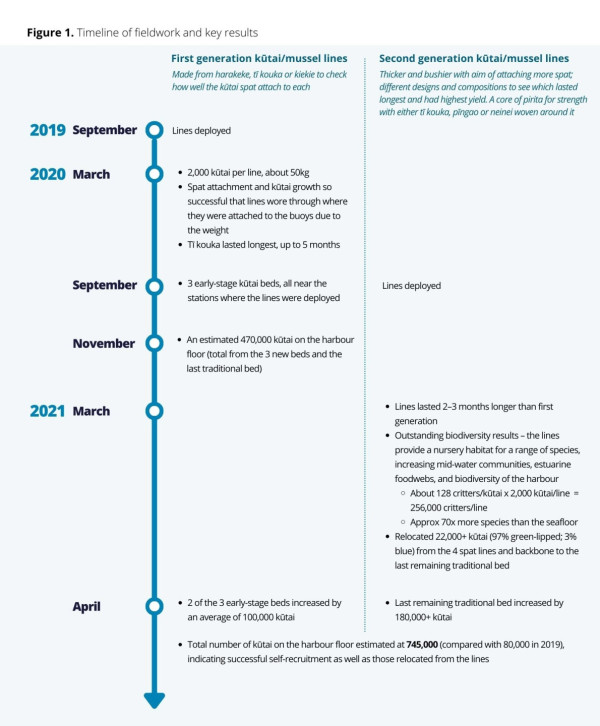- Summary
Mātauranga Māori material science is restoring mussels
This impact case study describes how a Mātauranga Māori and science collaboration is restoring kūtai/mussel beds and community connections in Ōhiwa Harbour (August 2021)
Three of four kūtai/mussel beds in Ōhiwa Harbour have disappeared. In 2007, one bed had 112 million baby kūtai – by 2019 there were less than 80,000 in the entire harbour. Kūtai are a taonga species for local iwi, and crucial to the health of this ecosystem. Meanwhile, the pātangaroa (11-arm seastar), which eats kūtai, population has exploded to 50,000 per hectare; 15 per hectare is considered a balanced number.
The disappearance of kūtai has affected the harbour’s kaimoana (seafood), mahinga kai (cultivation) and mauri (vital essence), and reduced the ability of mana whenua to express manaakitanga (expression of respect and hospitality to visitors through provision of kaimoana).
The Awhi Mai Awhi Atu project is using mātauranga Māori and marine science to investigate habitat restoration and connectivity, and better understand ecosystem degradation of the harbour. The project created unique natural fibre aquaculture lines using tī kouka biowaste (fallen cabbage tree leaves) and other natural materials to successfully help restore kūtai beds, increase biodiversity; and reduce plastic pollution in the harbour.
The biodegradable lines – with their kūtai – eventually fall to the bottom allowing the kūtai to attach to the harbour floor as the foundation for a new bed. Kūtai naturally grow together in clumps ‘as a whānau’, so falling together is important. The project has set up 4 ‘restoration stations’.
This mahi brings together mātauranga Māori with marine science. For example, the team used intergenerational kaumātua knowledge to determine the best place to put mussel stations; map traditional beds and identify how, and from which materials, to weave natural fibre lines. Marine science was used to help monitor the beds and identify biodiversity on the lines.

Rokahurihia Ngarimu-Cameron , a renowned master weaver, and her students co-developed and wove the lines with the research team. Rokahurihia overcame the material science challenges: using traditional weaving methods such as a core of piritā for strength for the second-generation lines to increase their durability, with either tī kouka, pīngao, harakeke or neinei woven around it.
"Our ancestors said that tī kouka was the strongest, but they may not have used pīngao and neinei for this kind of hard-wearing use despite them being hardy plants. Pīngao was precious for her beautiful golden colour so only used for tukutuku and prized kete.” – Roka Ngarimu-Cameron, master weaver
Impact
The impact of this hands-on participation is profound, both for individuals and for interdisciplinary capacity building of the next generation:
- 82yo kaumatua (elder) who got stuck in the mud helping do sediment cores: “Best day ever!”
- 3 young Māori women who had never considered a career in marine science are now studying BSc in marine science and Māori studies.
- Te Rūnanga o Ngāti Awa – The researchers share how pūtaiao (science) and mātauranga Māori can be used by kaitiaki to understand local issues with 16-20yo every December.
- 2 Māori marine PhD students doing their research in the harbour using mātauranga Māori and marine science.
- 1 young Māori engineering student doing her summer research project on natural lines using mātauranga Māori and engineering science.
- 1 young Māori woman doing her Master thesis research on kūtai, natural lines and plastic pollution using mātauranga Māori and environmental science.
- Kura Paul-Burke, Project Leader:
“Our kaumatua spoke about how proud they are – when they attend hui other iwi are making comment about how Ōhiwa Harbour are doing action, doing kaitiakitanga and making a real difference for their mokopuna and their moana.”
The research is endorsed by the Ōhiwa Harbour Implementation Forum and supports objectives in Te Rūnanga o Ngāti Awa and Te Upokorehe iwi environmental management plan.
The research team has received numerous requests for information from iwi (and scientists) across Aotearoa, and international indigenous groups.

Who’s involved
- Iwi – The iwi of Ōhiwa harbour have co-developed the research from the beginning, and gifted the project name which means ‘embrace this way, embrace that way’ (help me to help you), signifying the research priorities of using both mātauranga Māori and marine science to help the harbour. Iwi actively lead and are involved in all stages of the research.
- Ōhiwa Harbour Implementation Forum (co-management group of four iwi and three councils) – co-developed the project. The research supports the forum’s Ōhiwa Harbour Strategy.
- Bay of Plenty Regional Council – Co-funded and involved summer interns in fieldtrips.
- Local schools – 2 Kura Kaupapa Māori and 1 High School involved in fieldwork and classroom education.
Contact
Kura Paul-Burke [email protected]
Research organisations
University of Waikato, NIWA, Eco Research Associates Ltd, MUSA Environmental
